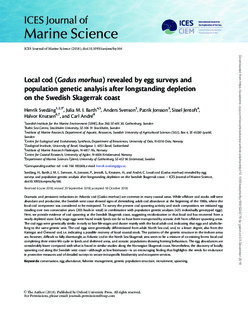| dc.description.abstract | Dramatic and persistent reductions in Atlantic cod (Gadus morhua) are common in many coastal areas. While offshore cod stocks still were abundant and productive, the Swedish west coast showed signs of diminishing adult cod abundance at the beginning of the 1980s, where the local cod component was considered to be extirpated. To survey the present cod spawning activity and stock composition, we initiated egg trawling over two consecutive years (203 hauls in total) in combination with population genetic analyses (425 individually genotyped eggs). Here, we provide evidence of cod spawning at the Swedish Skagerrak coast, suggesting recolonization or that local cod has recovered from a nearly depleted state. Early stage eggs were found inside fjords too far to have been transported by oceanic drift from offshore spawning areas. The cod eggs were genetically similar in early to late life-stages and cluster mainly with the local adult cod, indicating that eggs and adults belong to the same genetic unit. The cod eggs were genetically differentiated from adult North Sea cod, and, to a lesser degree, also from the Kattegat and Öresund cod, i.e. indicating a possible recovery of local coastal stock. The patterns of the genetic structure in the inshore areas are, however, difficult to fully disentangle, as Atlantic cod in the North Sea-Skagerrak area seem to be a mixture of co-existing forms: local cod completing their entire life cycle in fjords and sheltered areas, and oceanic populations showing homing behaviours. The egg abundances are considerably lower compared with what is found in similar studies along the Norwegian Skagerrak coast. Nevertheless, the discovery of locally spawning cod along the Swedish west coast—although at low biomasses—is an encouraging finding that highlights the needs for endurance in protective measures and of detailed surveys to secure intraspecific biodiversity and ecosystem services. | nb_NO |
